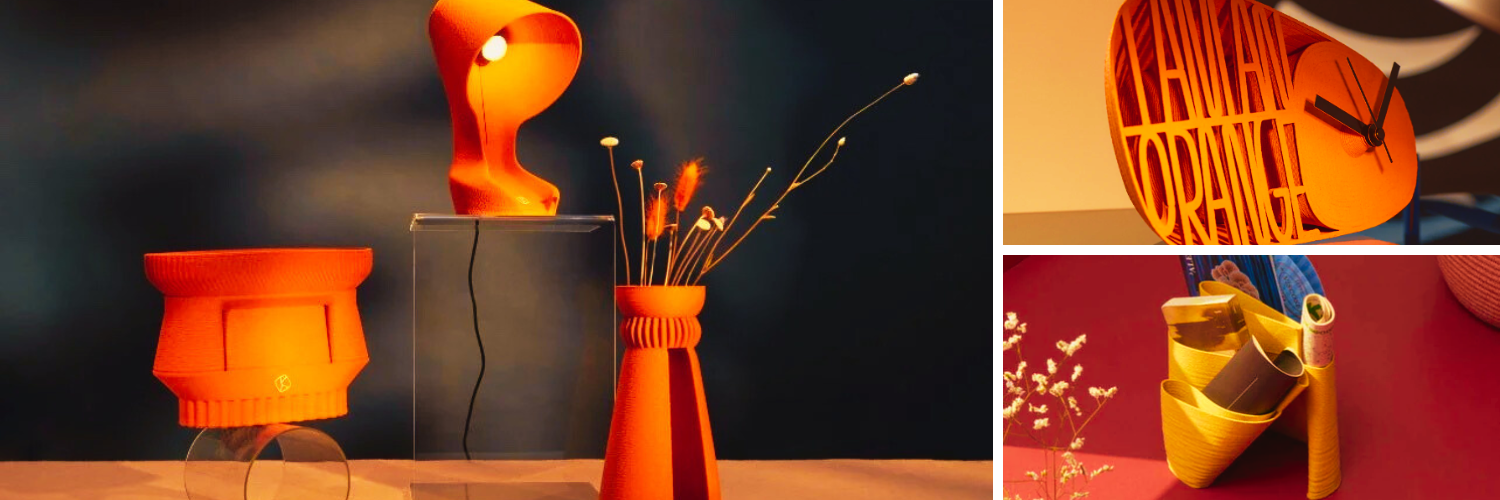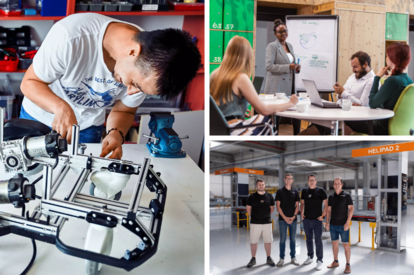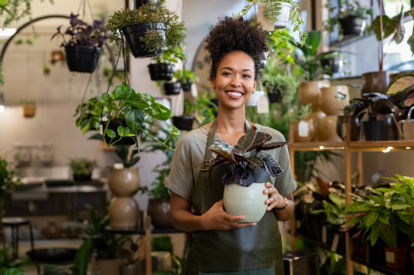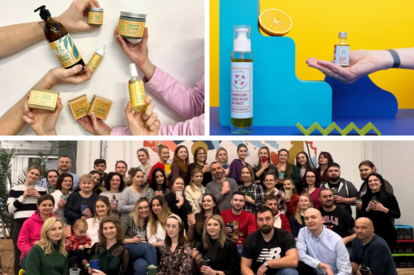
Krill Design, a start-up in Milan, turns food waste into 3D printed, stylish homeware. Discover their inspiring journey and get 5 insider tips on how to incorporate eco-design into your business.
Less waste, more value
Like fast fashion, “fast furniture” is cheap, easy to obtain, and quickly discarded. Each year, EU citizens toss out over 10 million tons of furniture, but only 10% of it gets recycled. Eco-design counters this trend by creating durable, ethical, and sustainable products that serve both people and the planet. It embraces the “three Rs” of circular economy – reuse, repair, and recycle – throughout a product’s life. The goal is to use things longer, reduce waste, and encourage people to become mindful consumers.
Eco-design offers several benefits for small businesses. First, it helps them reduce their environmental impact by making more robust products with fewer resources. Second, companies save money and boost profits over time. For example, using energy-saving lighting, climate control systems, and long-lasting materials can significantly cut utility and replacement costs. Plus, businesses can get funding for green initiatives though programmes like Horizon Europe and LIFE. Enterprises that use recycled materials may also qualify for subsidies like VAT exemptions under the EU Green Deal’s Circular Economy Action Plan.
Third, a growing number of consumers prioritise sustainability when making buying decisions. Businesses that sell products aligned with these values are more likely to attract eco-conscious buyers. Take Xeraliving, for example. This small Finnish business stood out in the crowded home décor market by selling premium items made from responsibly sourced linen and organic cotton.
Finally, eco-design plays a crucial role in driving the shift towards a circular economy, where products are reused and repurposed. To get there, small companies need to think creatively, innovate more, and use resources efficiently. Investors are increasingly drawn to this mindset, seeing sustainable projects as profitable, resilient, and environmentally responsible. Pepper Valley, for example, secured investment for their e-textile innovations, including their patented knitwear with AI-powered sensors that tracks health in real time.
Turning food waste into sleek décor
In Milan, three architects – Ivan Calimani, Martina Lamperti, and Yack di Maio – had a bold idea: transform food waste into fully biodegradable and compostable homeware. The trio noticed that while paper, glass, and plastic are recycled, food waste piles up in landfills, chokes rivers, or is incinerated. Food waste generates 8-10% of global greenhouse gases, with the food and beverage industry being a big part of the problem. Since 2018, Krill Design has been repurposing food waste into sustainable, circular design products.
The Italian start-up takes unexpected materials (like fruit peels, orange seeds, and coffee grounds) and turns them into chic design items ready to add a pop of colour to your living room. Their collection includes stools, vases, fruit bowls, clocks, and the iconic Ohmie desk lamp made from blond Sicilian oranges.
Krill Design not only sells retail items but also collaborates with major corporations. For example, they transformed Sanpellegrino’s orange peels into elegant table lamps, trays, and ice buckets. They’ve also used coffee scraps to create tampers and cup warmers for Gruppo Cimbali, and have designed accessories for 4,000 Autogrill stores worldwide. Other big-name clients include Lavazza, Illy, Lurpak, and Four Seasons.
To produce each item, the team follows a four-step process. First, they gather, dry, and grind the food waste into a fine powder. Then, they mix the powder with their patented biomaterial, Rekrill. Next, the mixture is shaped into a filament and wound onto a spool. Finally, the filament is fed into a 3D printer to create objects that not only look, but also smell and feel like fruit or coffee.
The company’s creativity and innovative approach have earned them numerous accolades, such as the Gaetano Marzotto Special Award for Innovation in 2020 and the Confindustria Award for Best Performing Company in the Circular Economy in 2022. Their products have been featured in major publications like Vogue, Wired, and The Guardian.
One of the start-up’s boldest initiatives is the Sustainable Fu(rni)ture project, which develops a wide range of new materials from food waste. Unlike the industry norm, Krill Design uses 3D printing to make the final product, not just a prototype. The Enterprise Europe Network business advisors at Confindustria Lombardia helped them put together a strong project proposal and secure funding from the European Regional Development Fund, accelerating their growth in the sustainable design space.
5 lessons entrepreneurs can learn from Krill Design
Be smart with your resources
Krill Design is committed to creating high-quality design items that have minimal environmental impact, and their CEO, Ivan Calimani, stands by this mission with passion. "We make sustainable and innovative products for a better world", he explains. "Zero waste means we work with what we already have". Small companies can be resourceful in many ways: turning waste into new products, finding new uses for leftover materials, and even sharing materials and transportation with other businesses.
Imagine you want to trim your energy expenses. You can switch to energy-efficient equipment, improve insulation, and use smart heating and cooling systems. It may sound basic, but small fixes compound. New tech like AI, digital twins, and 3D printing can reduce waste, too. These tools will help you automate tasks, launch products faster, and tailor your offerings to each customer.
Merge functionality and aesthetics
True story: Consumers are drawn to products that are not only functional but also aesthetically pleasing. Krill Design nails this with products that are both sustainable and beautifully crafted. Each piece in their collection is inspired by Italy’s stunning landscapes, preserving the organic shapes, textures, and scents of nature. "We believe an upcycled product should match the quality and aesthetics of a brand-new one. Our goal is to create sustainable and circular home décor that is visually appealing and enjoyable to use", says Calimani.
Take a fresh angle
Sticking to what you know might feel comfortable, but it doesn’t always lead to growth. Drawing inspiration from other industries can open the door to creativity and innovation. For instance, Krill Design started by using orange peel waste for its products, but later expanded to materials like eggshells, tomatoes, and grape leftovers.
Collaborating with partners from different sectors can also pay off significantly. "It’s crucial to set up circular economy processes that involve companies across the supply chain," explains Calimani. "We show companies how their food waste can be transformed into valuable products for their customers. It’s an end-to-end approach."
Educate and engage stakeholders
Effective communication is key for a winning sustainability strategy. Start by educating your employees with workshops and training on eco-design and sustainability. Keep them informed about your goals and encourage their feedback. It’s also crucial to consider your investors. Make sure to highlight the advantages of sustainability in your pitches and reports, whether that’s reducing costs, managing risks, or boosting competitiveness.
Help your consumers make more sustainable choices by focusing your marketing on the tangible benefits of your products, such as healthier living, saving money, or protecting the environment. Share useful content on your website, blog, or social media to raise awareness about eco-design. Partnering with other companies, influencers, or advocates can help you reach a larger audience. And why not offer product demos or factory tours to give customers an inside look?
Build a strong support network
A strong network opens doors to valuable resources, new opportunities, and a supportive community. Krill Design, for example, collaborated with companies across the supply chain to access raw materials and distribution channels. Being part of Lombardia’s vibrant start-up scene and partnering with Enterprise Europe Network helped them attract investors and customers. Wondering how the Network can support your business? Reach out to your Network local contact point today.
Marcello Panzone is a Project Manager at Enterprise Europe Network in Confindustria Lombardia. He also serves as an ambassador for the European IP Helpdesk, helping small and medium-sized companies manage their intellectual property.
Alessandro Ingegno is a Communications Manager at Confindustria Lombardia. He has a journalism background and vast experience in Italian media.
This article was co-authored by Ruxandra-Laura Bosilca, PhD, Social Media and Community Manager for Enterprise Europe Network.
Related articles

Start-ups need funding, mentorship, and networks to scale. Big companies are looking for fresh ideas, disruptive tech, and faster ways to stay ahead. When they join forces, both sides win. Keep...

Peer learning can help you make better decisions, expand your network, and seize new opportunities as an entrepreneur. Check out our 5 tips to make the most of it and see how the Enterprise Europe...

Embedding sustainability into your daily business operations is not only beneficial for the environment, but can also improve your brand reputation, reduce costs, and attract socially conscious...

As clean beauty is reshaping the cosmetics landscape, Four Starlings – a family-owned soap-making business in Poland – is gaining international recognition. We spoke with Grzegorz Sienkiewicz...

